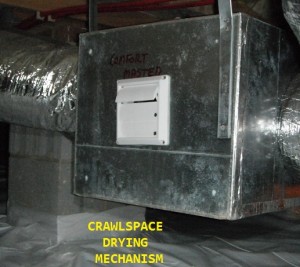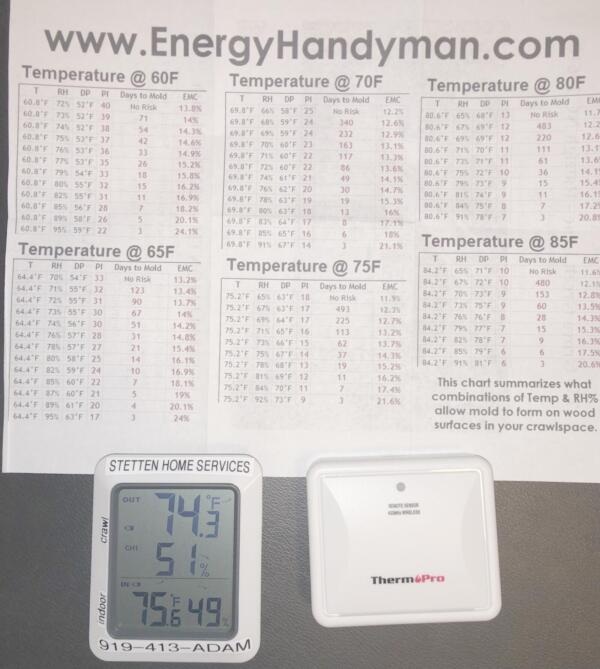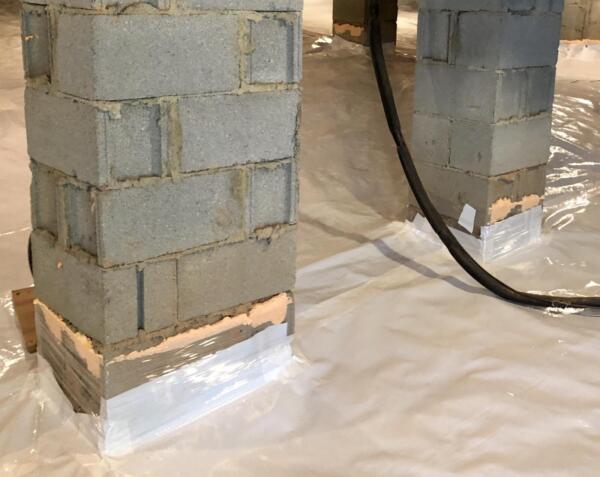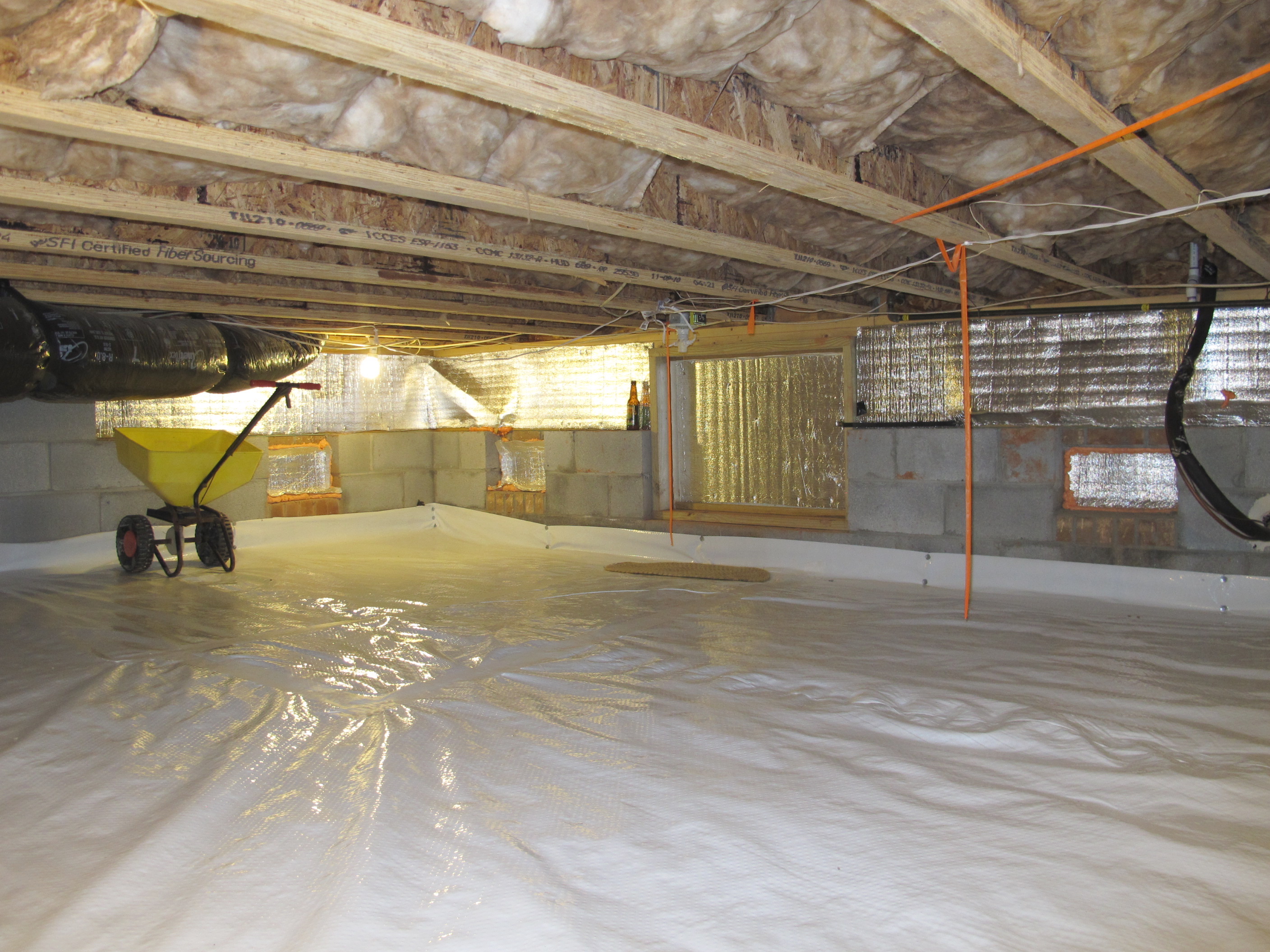
The above crawlspace is mostly below grade and was collecting water in two low corners. Drainage was improved, and now the foundation vents are plugged and sealed, with special care taken to make the vapor barrier effective and durable. Now just a trickle of HVAC supply air from the existing supply-trunk keeps it dry and comfortable. The temperature fluctuates between 65 and 74 degrees and humidity ~65% or less. This is just one example of a sealed crawlspace. The first step is monitoring and understanding crawlspace moisture.

A properly SEALED crawlspace has no wall vents, or the wall vents have been sealed permanently. 100% of the ground is permanently covered with a sealed vapor-barrier which is sealed to foundation walls and piers. All gaps and seams are taped or sealed with foam. Exterior grading moves all rain-water away from the foundation. The main point is keeping ambient air out of the crawlspace and actively drying and monitoring the space. A low-point drain, will release water if plumbing fails but no exterior moisture in any form, Humidity, Rain, or Irrigation can get in. Although we do a great job treating the interior of the shoe-box, our sealed crawlspaces alone will not fix bad water-proofing, or poor design outside the shoe-box. If during construction the builder grades the exterior soils and interior soils properly and takes care to keep all the soils inside and around the foundation from being saturated, the need for drying is greatly reduced. In fact, a sealed crawlspace does absolutely nothing to protect the foundation footings from migratory water and can make it difficult to see and deal with migratory water that is the main cause of structural failure in Raleigh NC.
In addition to those “fundamental methods”, a sealed crawlspace might need to be insulated and otherwise renovated to provide storage, accessibility and functionality per the client. If you have leaky, old, duct-work inside the space, it can save money and increase comfort to insulate the walls well.
DRYING MECHANISM – in North Carolina, Building Code requires Drying and provides 3 options. Unfortunately, building code does not require a monitor or adjustability.
1) Borrow a trickle of air from your home’s existing supply duct-work. This is a great choice! Drying is active when the Heat or A/C is running. This method tends to keep the crawl within just a few degrees of the home. Floors will feel warmer in winter and cooler in summer. Below, Right.
Below, Right.
2) Take air from inside the home. From inside it is just another floor register, we usually put it in the pantry, mudroom, or “pet area”, with an in-line exhaust fan and blow it into the crawlspace. This would be used in a home with no accessible ducts in the crawlspace and no way to get a duct down. Controls would be adjusted to blow more air if there is a big difference in the indoor and outdoor temperature or it is humid down there. These days “inline exhaust fans” may come with 3 speeds and an on/off switch. This method also ventilates your house, and can be used statically to depressurize a certain smelly room if that is needed. Cons, additional equipment and energy use, tends to run when not needed, may fail and need replacement. Chances are if your windows are open or your home is holding a comfortable temperature despite the weather, and you aren’t feeling the need to heat and cool your home, I don’t really know if I would want to be blowing air-out of my comfortable home. not pictured. Some contractors use the same or similar equipment to “exhaust” air from the crawlspace with an assumption that this wasted air will be replaced by air from the house, but many crawlspaces have a long, linear, leak located at the sill-plate so this method only dumps potentially humid, too-hot, or too-cold air into the crawlspace.
3) Use a dehumidifier. Chances are great there is a better method. Essentially it is a window unit air-conditioner with an RH gauge instead of a temperature gauge, water is pumped out through a flexible tube. The home’s existing equipment should be able to keep the entire structure dry, and the foundation should be built to stop infiltration. Best-Buy sells dehumidifiers. not pictured.
A typical Sealed-Crawlspace includes: (After site water flow and roof water flow is resolved, ideally.)
- Debris Removal & maybe Insulation Removal
- Cleanup
- Foundation Repair (rarely)
- Plumbing Repair (rarely)
- Floor Liner, Wall Liner, and Vent-Plugs
- Air-Seal Foundation Wall. Seal seams in vapor barrier with Tape
- Seal and Insulate Crawlspace Wall and Band-Joist with Spray-Foam.
- Build Access Door
- Cleanup
- Signage
- Monitoring. This allows the occupant to regularly check the performance of the space. You can scroll through high and low temps and humidity levels. You can place additional sensors in ambient, attic, and the indoor display can be installed next to the T-Stat.
What does your crawlspace need?

Please contact us if you have any questions.





